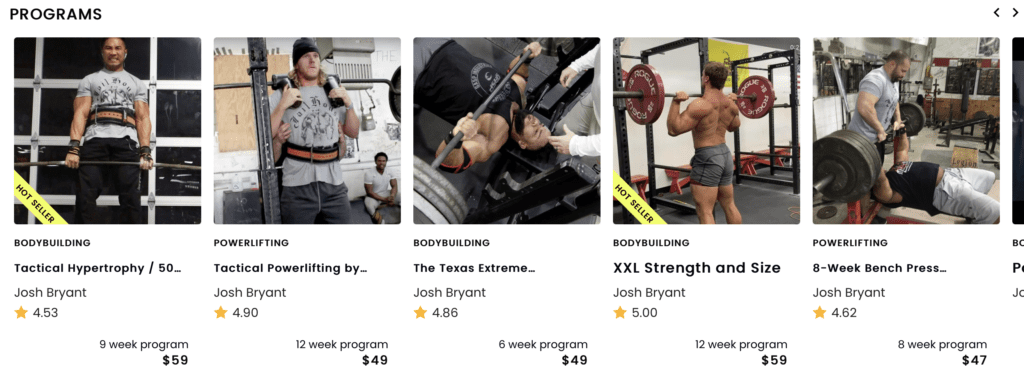Gym Efficiency Masterclass: 5 Sneaky Ways to Boost Volume While Saving Time
by: Josh. Bryant

These strategies helped Johnnie grow under Josh’s tutelage.
The neon glow of that old Conoco sign taunted me with the promise of lukewarm coffee and questionable street tacos.
But this wasn’t just any gas station pit stop – this was due west of the ol kick’n stab bar.
Across the street, five carney-looking meth heads in a beat-up Buick ogled my car with eyes brighter than their brake lights, while from the shadows of a welding shop emerged two dudes that looked like the love child from a love triangle of Cocaine, hookers and steroids.
Panic started to creep in, but before it could bloom, a figure stepped out of the Conoco’s haze.
Brother Barrett, as he would come to be known, wasn’t your average gas station attendant. He was a monument of muscle, traps like granite slabs and forearms that could crush anvils. He scanned the scene with a desert sage’s calm, then uttered a single word that sent the Buick Boys and welding warriors scurrying like tumbleweeds – “Go.”
That’s when, over some sketch street tacos that tasted suspiciously of regret, Brother Barrett dropped a muscle-building bombshell: high-volume cluster sets.
Forget marathon gym sessions, he preached, “Pack more work into less time, and your muscles will sing a savage symphony of growth.” His wisdom ignited a fire in my weary bones. I couldn’t dedicate hours to the iron temple, but the promise of efficiency, I couldn’t resist. So, I embarked on a quest, venturing deep into the dusty archives of scientific studies and grimy gym forums, unearthing five battle axes of muscle-building that I now offer to you!
Supersets
Start by forgetting everything the “bro science” personal trainer at the preppy chrome-palace fitness center told you about supersetting.
Supersetting is not working the same muscle group to fatigue with multiple consecutive sets without a rest break.
In fact supersetting is a method that pairs two exercises for opposing muscle groups back-to-back without rest. Publisher Joe Weider popularized this concept and stressed the word opposing to emphasize that the two exercises in the superset are opposite motions, like a bench press and row for back, or a triceps extension and a biceps curl.
The take home lesson is that you can train two body parts with the same amount of rest as you’d need with traditional straight-set training.
This won’t sacrifice strength and power. In fact, it may even enhance it.
A 2009 study published in the Journal of Sports Sciences, “Effects of agonist-antagonist complex resistance training on upper body strength and power development,” demonstrated the powerful 1-2 punch of superset training.
Over eight weeks, the group that supersetted the bench press with bench pulls (an opposing pulling movement for the upper back) significantly increased both bench press and bench pull, compared to the ‘traditional sets’ group that only saw improvements in peak power for the bench press throw. The supersetting technique appeared to be more time-efficient with respect to the development of 1-RM as well.
In support of these findings, an earlier 2005 study published in the Journal of Strength and Conditioning Research found that rugby players with strength-training experience increased power by 4.7 percent more when training the bench press throw as a part of a superset as opposed to doing the bench press throw alone
Bottom line: Science says you’ll save time, do more work, and quite possibly become more powerful when training with supersets.
How To Use It
When supersetting, it’s important to note that rest time between the two exercises is kept to an absolute minimum—otherwise, it becomes two distinct sets. Do all repetitions back-to-back. Below are sample superset pairings. After you complete both exercises take a brief rest, just long enough to allow the heart rate to fall back to a manageable level (approximately 100-120 beats per minute). Then proceed to the next superset.
Body Part Pairings Exercises
Chest/Back Dumbbell Bench Press/Dumbbell Bent-Over Row
Abs/Low Back Crunch/Back Extension
Shoulders/Back Overhead Press/Lat Pull-down
Triceps/Biceps Push-down/EZ-Bar Curl
Hamstrings/Quads Romanian Deadlift/Sissy Squat
2. Cluster Sets
Cluster sets are those in which the main sets are broken into several parts—for example, instead of doing a set of six reps you do a set of 2+2+2, which allows for a very short rest period within the set. That intraset rest period allows you to lift more total weight for more sets—a great anabolic stimulus. For bodybuilding purposes, the rest period can be very short but no more than about 20 seconds.
Olympic lifters have used cluster sets for over half a century and powerlifters have for decades. Now, even more aesthetically minded individuals are hopping onboard. I personally have used this technique training IFBB pro bodybuilders Johnnie Jackson, Cory Mathews, and Branch Warren.
Strength athletes like cluster sets because they can produce greater amounts of force and velocity over the duration of sets. Bodybuilders like them because they can get more done in less time. And research has shown that relative intensity of training is greatest when using cluster sets (3).
Next time you’re training triceps, instead of your traditional three sets of 12 use the same weight for five reps, rest 20 seconds and repeat this sequence for five minutes straight. You’ll get a helluva lot more volume done in less time!
If you’re training for strength, instead of three sets of five reps with a full 3-5-minute recovery, try six sets of three reps with a 90-second recovery. You’ll be done faster and get in more work.
The Bible of Cluster Sets
3. Warm-ups
Most of us start our workouts by leisurely riding on the exercise bike for 10-20 minutes as part of a warm-up. While a few minutes will do some good, instead use this time to prepare for the task at hand–slaughtering some pig iron!
Since volume is the product of resistance multiplied by sets multiplied by reps, even three sets of 10 reps with an empty Olympic barbell is a staggering 1,350 pounds of extra volume (45x10x3).
Remember, strength is a skill. Skill development needs practice, so practice by warming up with the movement you’re performing. Keep in mind, we’re not talking about pre-exhaust training, just 3-5 extra warm-up sets with light weight in place of a traditional cardio machine.
If you’re going to train with 225 pounds on the squat, give this warm-up sequence a shot: 45 pounds x 6 reps x 4 sets, 95x5x3, 135x4x1, 175×2, 205×1, and then finally do 225.
This strategy increases volume, decreases fatigue, and will have you performing better!
4 Staggered Sets
A 1988 study showed that shot putters increased throwing distance and vertical jump height by training only the fingers and the toes . If you want to be your best, you must sweat the small stuff.
Taking care of neck, forearms, abs, calves and other “smaller” muscle groups that are easily skipped over is essential for optimal performance, staying injury-free, and having a symmetrical physique.
Most lifters just tack these “extras” on at the end of a workout; best-case scenario if they’re faithful it is an extra 15 minutes or so in the gym. More often than not, the “extras” get skipped, be it getting home to watch Monday Night Football or just feeling tired and ready to leave the gym.
Joe Weider is credited with coming up with this solution—staggered sets.
Staggered sets involves training one of the smaller muscle groups between sets of a larger one. So when you’re recovering between heavy sets of bench presses, you’re doing a set for calves. Pairing a smaller muscle group with a larger one minimizes fatigue; while the smaller muscle group is working, the larger one is recovering and vice versa.
The caveat here is that you can’t pair exercises that might interfere with your ability to complete the bigger move. If you’re deadlifting today, avoid staggered sets that involve your grip (you have to grip the bar on deadlifts), no biceps work, and heavy hamstring workout is out.
In 2008, Dr. Alcaraz’s lab confirmed what those in the trenches have known for decades. His study compared two groups with prior strength-training experience, each performing two separate training regimens. One was a standard bench press workout of five straight sets and the second group performed the same bench press workout, doing leg extensions or calf raises between sets.
Bench-press performance was unaffected by including leg extensions and calf raises, coupled with the fact that training volume was achieved without adding one extra minute to the workout .
Does your neck need extra work? Hit some harness work between sets of biceps curls. Are your forearms lagging? Hit some Zottman curls between sets of leg presses.
Staggered sets make it clear: You have no more excuses to avoid the “small stuff!”
5 Dropsets
Here’s another oldie but goodie, but instead of performing these movements in a triple-drop-to-failure style, we’re instead going to focus on movement quality.
Using leg day as an example, after the first main movement of the day, your heaviest squat set, drop the weight down by 20 percent and perform 3-6 sets of 2-4 reps, resting 60-90 seconds between sets. Perform each rep on each set with a controlled negative and explode the positive as hard as possible.
This is called Compensatory Acceleration Training (CAT), the brainchild of my mentor, Fred “Dr. Squat” Hatfield (RIP). Keep in mind, lifting heavy weights requires you to produce high amounts of force (mass x acceleration = force). Most people just focus on the mass part, lifting heavier weights. For these sets you’ll do them with the highest amount of forcebut without sacrificing technique or tightness.
To reiterate, do this only for the first main movement of the day. If you train with 245 pounds on the bench press and perform the CAT sets with 205 pounds, just think of the extra volume with four sets of three reps. (4x3x205=2,460), that’s 2,460 extra pounds in one session!
With dropsets, serious volume can be accomplished without a serious time commitment. Furthermore, these sets allow for greater strength and power development as well as help build more efficient movement patterns, teaching the skill of strength.
Final Thoughts
You now have five ways that can help you get stronger and build muscle without having to spend any extra time in the gym. You’ll get more done without sacrificing quality. Take it and run with it; I’m excited to hear about your results, so make use of the comments section below.
To a stronger and more muscular you—time to hit the pig iron!
Get these principles in play with one of Josh’s Programs HERE.

